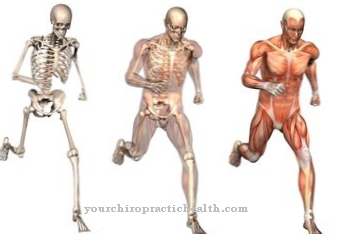Up to 20 percent of all young people injure themselves, with girls more often affected. The Self harm often occurs as a symptom of mental disorders or illnesses.
What is self-harming behavior?

Self-injurious behavior refers to actions in which the body surface is deliberately damaged. This means that the person concerned repeatedly injures himself. This can be done consciously or unconsciously. Self-harm is not an independent clinical picture, but a symptom of disorders.
However, these self-harms have no suicidal background. Most often they occur through cuts with pointed or sharp objects, such as a razor blade, knife or broken glass. This cutting or scoring is usually done on the arms and legs. Burns or chemical burns are also a form of self-harm.
causes
The causes of self-harming behavior include highly stressful events and experiences that often last longer. These include, for example, neglect by the parents, which leads to a lack of security, the separation of the parents, which children often cannot cope with, sexual abuse, low self-esteem, the tendency to emotional instability and the inability to express feelings, tension or anger to express in a different way.
Teenagers with mental health problems or disorders are at a very high risk of developing self-harming behavior. Other causes are mental illnesses such as depression, anxiety, panic, obsessive-compulsive disorder, eating or borderline personality disorder. The reasons for the self-harming behavior are very diverse. There is rarely only a single trigger for this.
This often conceals numerous causes and feelings that the person concerned associates with the behavior. In this case, the emotional burden is relieved through physical pain. The body reacts to pain with an increased release of endorphins, which results in a feeling of relief and relaxation. Often the self-harming behavior develops into an addiction that those affected have to pursue again and again. Without outside help, the urge to hurt yourself cannot be alleviated.
You can find your medication here
➔ Medication to lighten the moodDiseases with this symptom
- Borderline syndrome
- Tic and Tourette Syndrome
- Obsessive-compulsive disorder
- Post-traumatic stress disorder
- eating disorder
- Anxiety disorder
Symptoms, ailments & signs
In the case of self-injurious behavior, there are usually several injuries. First and foremost, these are cuts or scratches that are carried out on easily accessible areas, such as the extremities. The depth of the injury is usually the same and the injuries are often grouped, lined up in parallel or symmetrically.
In relation to the shapes, lines, letters and words are often observed. It is difficult for parents to recognize the signs of this behavior, as those affected usually hide their injuries under their clothing and do not let anyone in out of shame. It is therefore very important to respond to possible warning signs in order to get help early on.
Diagnosis & course
In addition to the physical damage, which can be minor, but sometimes just as severe or even fatal, self-harming behavior can also lead to psychosocial impairments, as feelings such as shame, guilt, stigmatization or a reduced self-esteem can arise. Those affected often suffer from disturbed sleep and mood swings. They neglect friends or hobbies and withdraw.
Due to the resulting scars, which they want to hide, they wear long clothes even on warm days. The diagnosis is made based on the injuries inflicted on the body. Severe forms of illness are caused by repeated injuries over a long period of time. Often the self-harming behavior develops into an addiction that those affected have to pursue again and again. Without outside help, the urge to hurt yourself cannot be alleviated.
Complications
If self-injurious behavior is not treated, it usually happens that the sick person injures himself to a very high degree and inflicts relatively great harm on himself. Such people usually injure their skin or other places. If this behavior is not treated, people often do not realize the damage they are adding to themselves and do not stop on their own.
In the worst case, this can lead to suicide or injuries, which can be life-threatening for your own body. These people often do not think about the consequences of harming themselves and inflict them without knowing that in the worst case they could die from it.
Treating the self-harming behavior usually involves using medication and talking to a psychiatrist. Most of the time, the drugs used have severe side effects. This includes tiredness, headache or listlessness. These side effects aren't particularly bad, their primary purpose is to keep the person from continuing to harm themselves.
As progress is made, weaker drugs that do not have such severe side effects can be used. In severe cases, treatment can also result in a stay in a closed psychiatric ward.
When should you go to the doctor?
In the event of self-harming behavior, it is always advisable to consult a doctor. If a doctor is not consulted, the affected person can sustain serious and life-threatening injuries. In the worst case, it can also lead to thoughts of suicide and ultimately to suicide. As a rule, self-injurious behavior should always be examined and treated by a psychologist. It can take a long time for the cause of the behavior to be found.
In many cases, the patient fails to see that he needs treatment and that he is suffering from the disease. In these cases, friends and family must force treatment and examination. It is also possible to have the treatment carried out in a closed clinic. Urgent action is particularly necessary if the patient has already suffered injuries and has been suffering from self-injurious behavior for a long period of time. In the event of acute injuries, an emergency doctor can also be called or the person affected can be taken to a hospital.
Doctors & therapists in your area
Treatment & Therapy
Often those affected do not succeed in freeing themselves from self-harming behavior. There is a good chance of getting rid of it through psychotherapy or behavioral therapy. The underlying problems are dealt with here, because it is fundamentally very important that the basic faults are recognized and eliminated. The person affected is supported in developing new coping strategies that can be used to respond to stressful situations.
It also learns to talk about emotions instead of expressing them in the form of self-harming behavior. The earlier the therapy starts, the better the chances of recovery, although there are also people who cannot be treated. The prerequisite for healing is always a secure relationship between the person affected, for example with a partner, a family member, friend or therapist. The therapy can be supported with medication, for example if there is severe depression, an anxiety disorder or obsessive-compulsive characteristics.
Relaxation techniques such as yoga can also help to strengthen inner balance. For the success of the therapy, the motivation to change the self-harming behavior is primarily decisive. Therapy that takes place against one's will usually does not help. Accusations and reproaches on the part of relatives are not advisable, as this can intensify the addiction to self-harm. Showing understanding is of greater help.
Outlook & forecast
The prospects and prognoses for self-harming behavior depend heavily on the severity of the symptom and the patient's will and can therefore not be universally predicted. In most cases, therapy with a psychologist is necessary to treat this behavior.
It usually takes several months for behavior to change. However, success cannot always be assumed. This also depends heavily on the patient's background and will. It is not uncommon for those affected to be treated in special clinics. In this case, there is often a positive course of the disease and the fight against the symptom.
If the self-injurious behavior is not treated, the patient will continue to injure himself. Often the behavior is accompanied by an aggressive mood. The affected person turns away from friends and family and restricts himself very much socially. This leads to social exclusion and thus often to depression and suicidal thoughts. In the worst case, the patient can injure himself so badly that it leads to suicide. Therefore, those affected should be left alone as little as possible to avoid life-threatening injuries.
You can find your medication here
➔ Medication to lighten the moodprevention
In principle, a change in pain perception cannot be prevented. However, people who are insensitive to pain can learn that injuries can be avoided. First and foremost, a stable environment is always important, in which there is love and security, in order to avoid the development of psychological problems from the start.
Responding immediately to possible signs can prevent the self-harming behavior from developing into an addiction. Relaxation techniques as well as physical activity can also help with prevention, as this represents a good "venti" to switch off, reduce frustration and anger and clear your head.
You can do that yourself
First of all, it is important to learn new coping strategies that can be used in place of self-harm. These should help to deal with the strong feelings without harming the body. If the urge to self-harm is acute, exercising can serve as a valve. A creative activity like painting can also serve as an outlet.
Distraction or relaxation exercises are also conceivable to control the strong feelings. If possible, you can contact someone you trust. A conversation about the current emotional state does not help to be alone. Doing something good for yourself, indulging in something can help those affected to reduce tension and the pressure of self-harm. If necessary, substitute actions for self-harm can be avoided, which, although stimulating the body, do not harm the body. For example, a cold shower, something spicy to eat or a rubber band that those affected can strap onto their arms are conceivable.
Which strategies help in individual cases must be tried out. In the longer term, it makes sense to deal with the triggers of self-harm. Psychotherapy in particular can be of great help. If, despite everything, self-harm has occurred, it is important to take good care of the wounds and, if necessary, to seek medical help.


.jpg)
























